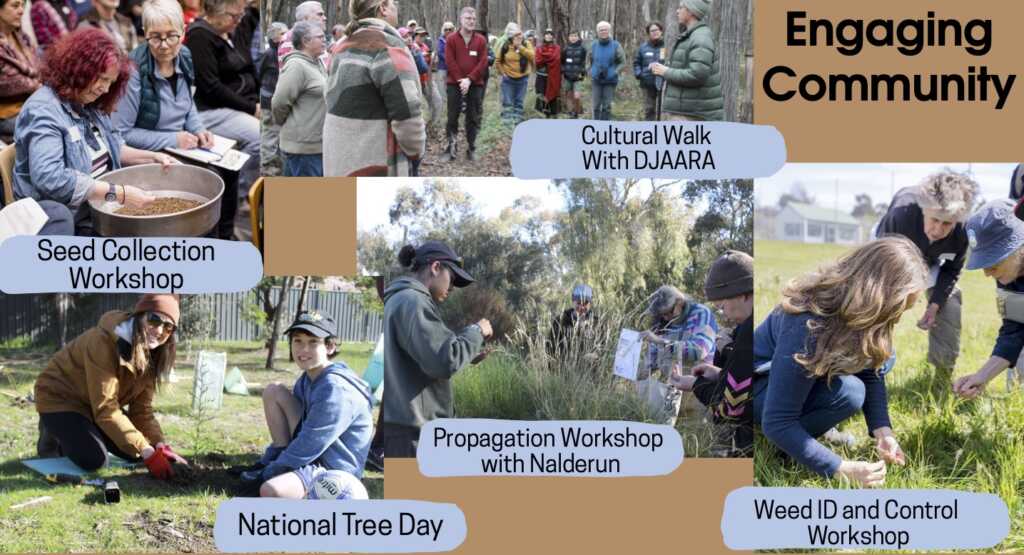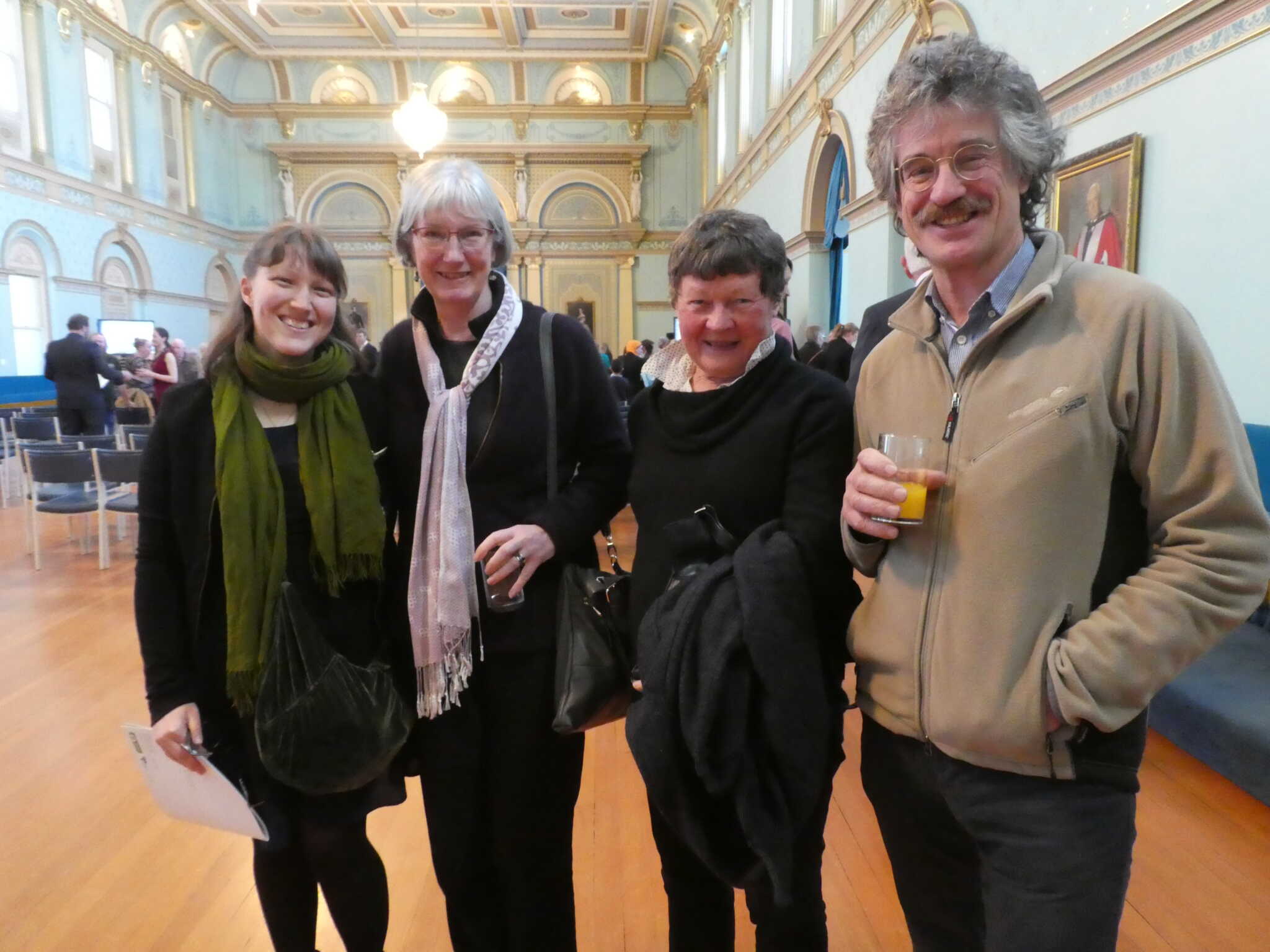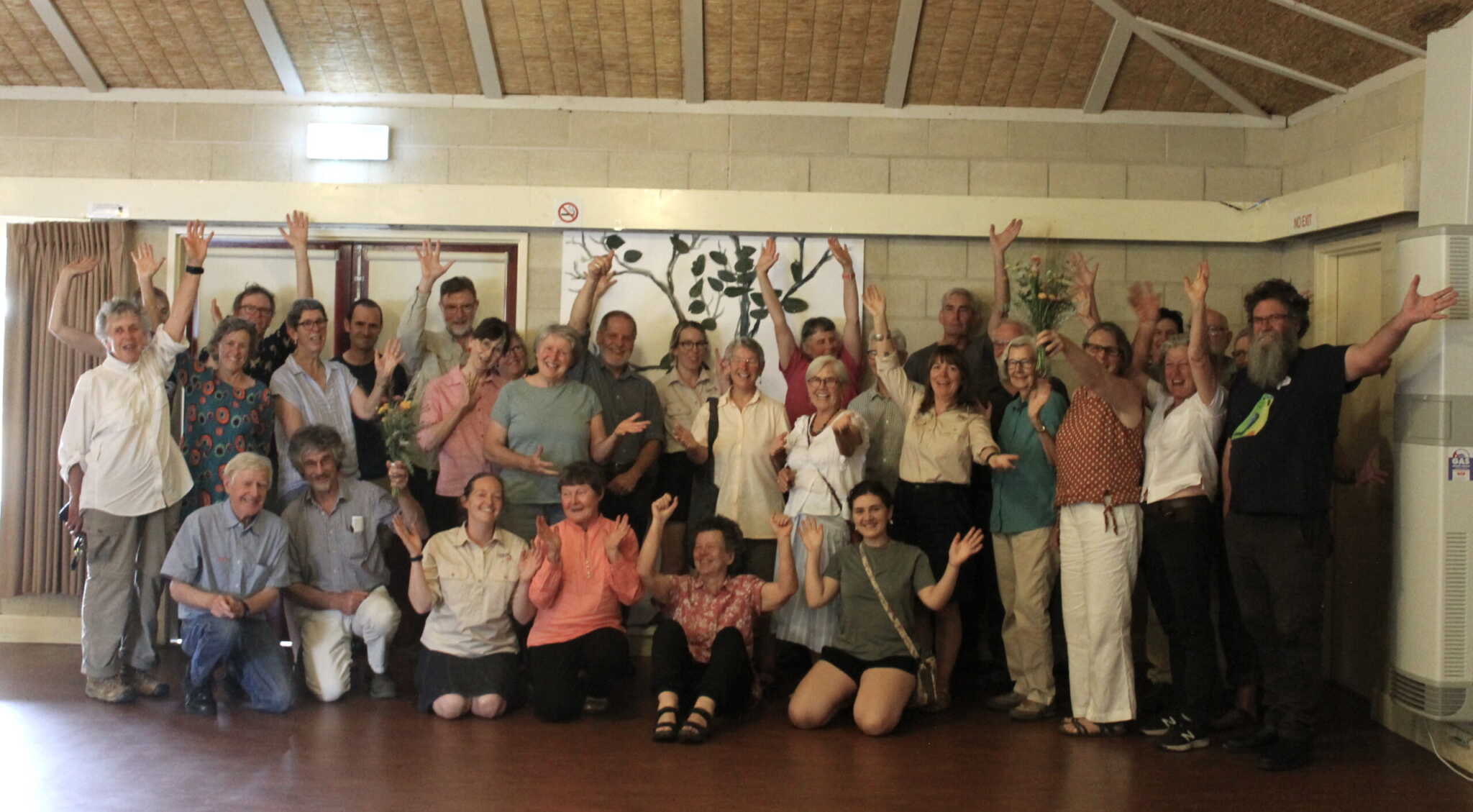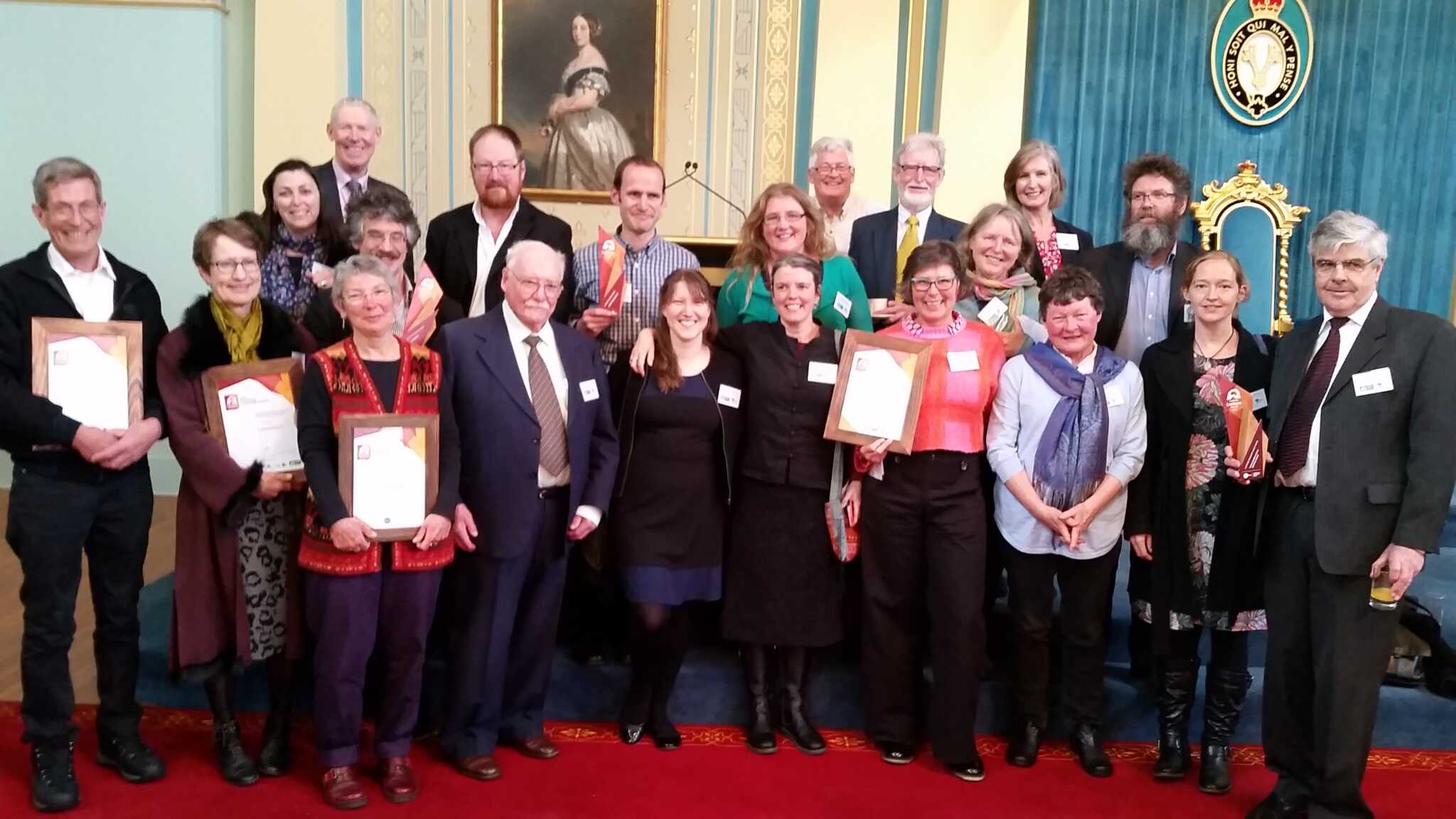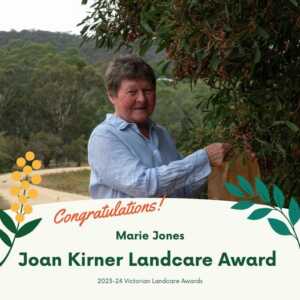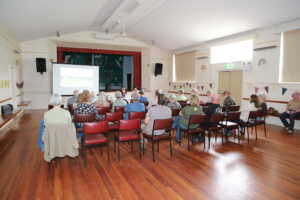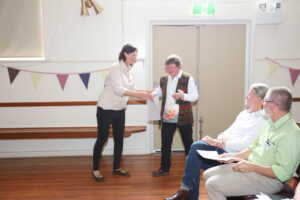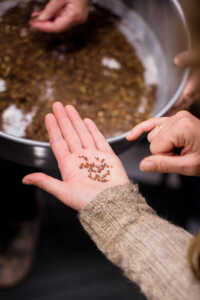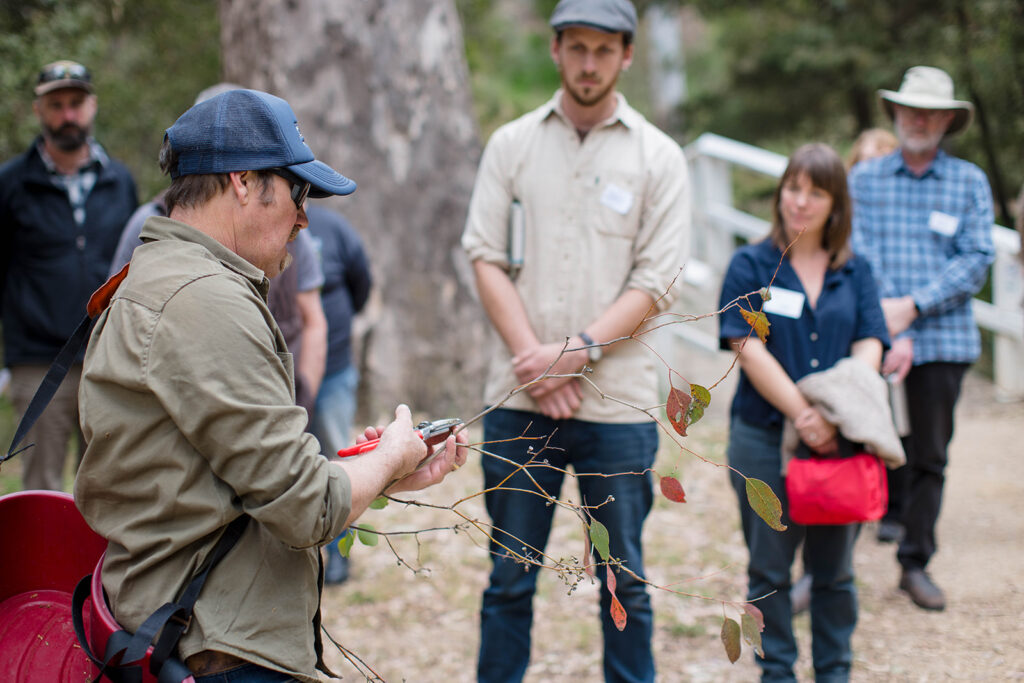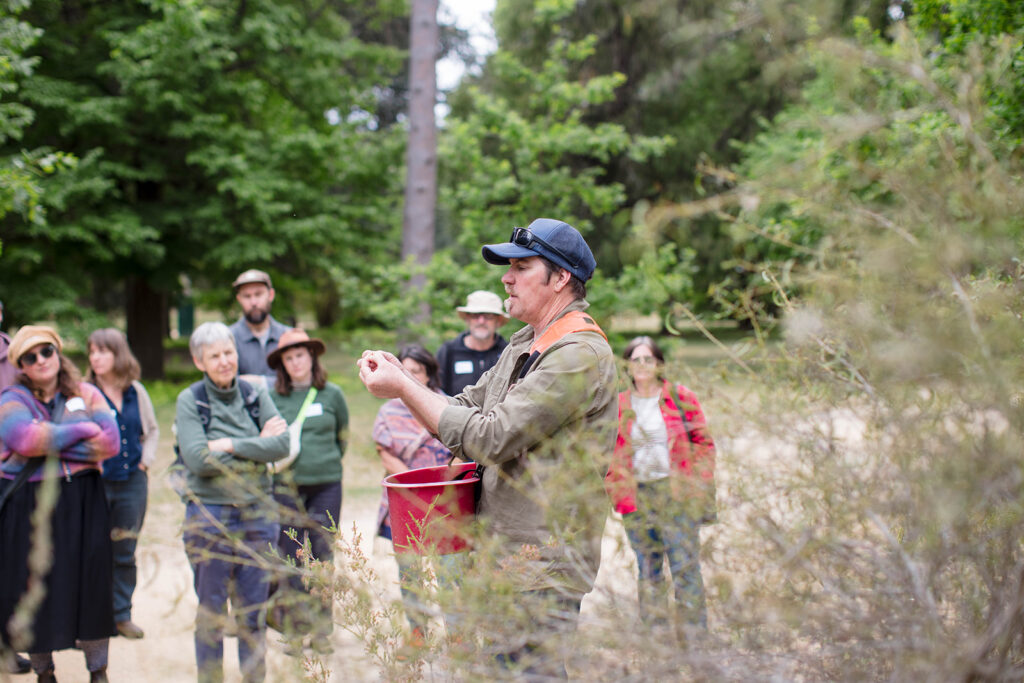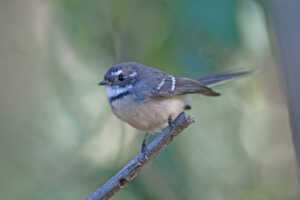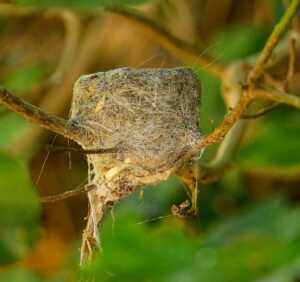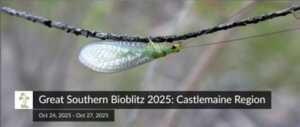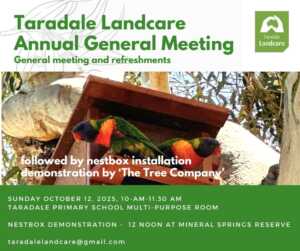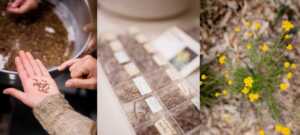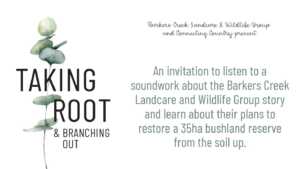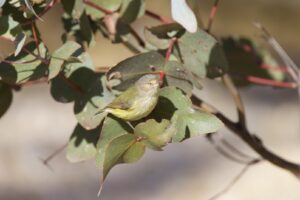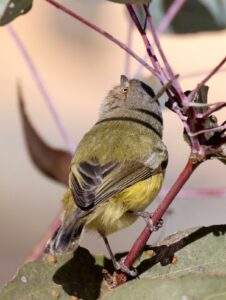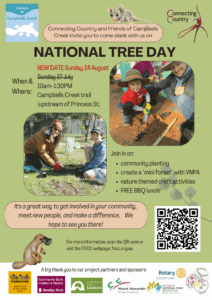2025 End of Year Retrospective
Posted on 22 December, 2025 by Hadley Cole
As the year draws to a close we clear our desks, hang up our boots, wash down the big red Connecting Country ute, and take a moment to think about what we have achieved this year. Like many environmental orgnisations 2025 has brought times of financial hardship and sadly the scaling back of staff and projects. Despite this the Connecting Country team, staff and volunteer committee members have rallied together and delivered numerous educational events attracting many community members from across the region, we continue to coordinate and deliver biodiversity monitoring through the engagement of volunteers and we partner with many local and regional organisations to deliver our events and projects.
Throughout the 2024/25 financial year we delivered 6 educational and community engagement events attracting around 350 people, supported 26 Landcare Groups, coordinated 192 bird surveys carried out by our dedicated volunteers and partnered with over 26 non-government and government organisations. For a small community not-for-profit organisation operating with less than a handful of part time staff and a volunteer committee we are proud of our achievements and remain dedicated to the work we do.
Connecting Country staff will be taking a break over the festive season. The office will be closed from Monday 22 December until Thursday 15 January 2026. Any inquiries made during this time will be responded to when we return to the office in January 2026.
We are so grateful to our donors, volunteers, and supporters! We wish you all a happy end of year and relaxing festive season.
Take some time to learn more about our achievements for the 2024/25 financial year in our annual report: 2024-25 Annual Report
Farewell Marie Jones after 17 years!
Posted on 11 December, 2025 by Hadley Cole
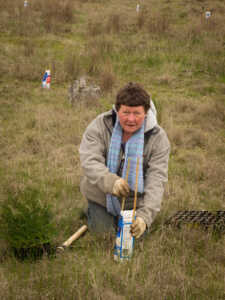 At Connecting Country’s 2025 AGM we wiped away a tear or two as we said farewell to Connecting Country stalwart and superstar Marie Jones. Marie has been involved with the organisation since its inception and has at one point or another held every single position on the executive committee, from Treasurer, to President, Secretary and all roles in between.
At Connecting Country’s 2025 AGM we wiped away a tear or two as we said farewell to Connecting Country stalwart and superstar Marie Jones. Marie has been involved with the organisation since its inception and has at one point or another held every single position on the executive committee, from Treasurer, to President, Secretary and all roles in between.
In 2007, Marie was instrumental in the creation of Connecting Country. Over the last 17 years she has worked tirelessly to ensure that Connecting Country is successful and sustainable. She has been involved in at least four sub-committees of the organisation including the Landcare Steering Group, where she provided hours of support and mentorship to the various staff that took up the role as the local Landcare Facilitator.
Marie began her volunteer career in the local community over thirty years ago! Throughout this time, she has guided many projects that will have a lasting impact on the local environment, heritage and people across the Chewton, Castlemaine and entire Mount Alexander region. She has been involved in many local community groups including, Golden Point Landcare, Post Office Hill Action Group, Friends of the Box Iron-bark Forests, just to name a few!
In 2024 Marie’s dedication to volunteering over the past three decades was recognised when she received the Joan Kirner Victorian Landcare Award. It was no surprise to the Connecting Country team when Marie’s name was called out. We all knew she was deserving of the award, we were thrilled that the rest of Victoria and the statewide Landcare community also recognised her contribution.
Photos above from left to right: The inception of Connecting Country. Fire & Biodiversity event (2014), Landcare Network Award (2017)
Marie is often the thread linking various community members and organisations within the Mount Alexander region together. She has a wonderful ability to bring people together and enable civil and respectful discussions around, what are at times, controversial topics. She is an exceptional grassroots environmental leader. She is the person people want to talk to about new ideas, about government funding, about issues groups may be having, about issues in the community, about working with other groups, about forming new committees or working on arising issues.
Perhaps one of Marie’s most outstanding achievements has been the work she put in behind the scenes to establish Connecting Country. Although its creation was a joint effort by many, everyone involved will attest that Marie was a driving force whose skills, knowledge and commitment were critical to its success. She was instrumental in engaging the widest range of stakeholders possible during the establishment process, particularly encouraging Landcare groups and their members to become involved, which they did. One of the defining things about Marie is that she takes a constructive and positive approach to any situation. She treats everyone as a person, with respect, no matter what disagreement or problem there is to work out.
Marie has a saying “think globally, act locally”, which articulates that the actions we take in our own patch can have a ripple effect across communities at the regional, state, national and even global level. Marie’s ability to keep all the parts of an issue in perspective is a strength that makes her relatable to many people within the community.
The entire Connecting Country community greatly appreciates Marie’s contribution, and whilst she has stepped down from the Committee, we know she will stay well-connected through Landcare and other local pursuits. We hope that stepping away from the Connecting Country responsibilities will create more time for her and her partner John to spend time with family and friends and enjoy some well-deserved down time.
Words from current Connecting Country staff and committee members about Marie:
I had known Marie for many years but it was after a FOBIF walk on my farm at Yapeen in 2016 that Marie approached me to join the Committee of Connecting Country. I have always been impressed by Marie’s energy, enthusiasm, excellent communication skills and her involvement in community and environmental matters. She has been an invaluable member of the Connecting Country Committee and a joy to work with. – Max Kay, Connecting Country Treasurer
It has always been a joy to come to work and see Marie. She is always helpful, supportive and knows just how to handle every situation. She has a knack of knowing exactly what is going on and what is needed at the right time. She will be greatly missed. Thankyou for everything Marie! – Bonnie Humphreys, Connecting Country Landscape Restoration Coordinator
I first met Marie when we were members of regional committees with the North Central CMA, almost 20 years ago, and she subsequently got me involved in Connecting Country when we moved to Faraday. Marie’s passion for environmental enhancement and protection, is well known, as is her great concern and support for the well-being of our communities. Her dedication to everything she takes on is awe inspiring. It has been a great pleasure working with Marie at Connecting Country – great conversations, many problems to solve, many laughs to be had and all in a very positive and cheerful way. I’m hoping there will be many more opportunities to work with her in the future. Can we call catching up for coffee “working”? – Chris Brooke, Connecting Country Committee Member
When I started at Connecting Country, Marie went out of her way to make me feel welcome with a coffee and a local field guide. She has always shown and appreciation and respect for staff, quickly responding to any queries and never shying away from the challenging issues. Her involvement across many aspects of the community means she always brought valuable community voice into project planning and decision making. I will miss Marie on the Committee but I know it won’t be the last we see of her. – Lori Arthur Connecting Country Director/ Landcare Facilitator
When I first started with Connecting Country as the Landcare Facilitator in 2021, Marie immediately made sure I knew she was their to support me in my new role. Her knowledge of the local community is incredible! She passed on so much information of previous projects, events and partnerships between local groups and community members. Whenever I had a new idea, Marie was the first person I went to, and still do! Despite the fact that she has witnessed all the various conservation trends over her years, she always endorsed my ideas with enthusiasm and support. Marie’s diplomacy and community spirit will be greatly missed by all at Connecting Country. Hopefully she and John can now take a well earned rest! – Hadley Cole former Landcare Facilitator.
Connecting Country AGM and new committee members
Posted on 25 November, 2025 by Hadley Cole
On Saturday 22 November we held our AGM at the Guildford Community Hall. It was a lovely day to get together and celebrate our achievements for the year. Connecting Country members and supporters enjoyed brief AGM formalities that were followed by a presentation from Dr. Barry Golding and a wonderful afternoon tea provided by the Guildford Store.
Dr. Barry Golding took the opportunity to reflect on his book Six Peaks Speak, published in 2023. Dr. Golding spoke of the great amount of evidence that is recorded in Central Victoria demonstrating Dja Dja Wurrung occupation of this Country for millenia, and the importance of protecting artefacts and culture that still exist in the landscape. The ‘Six Peaks’ refers to Mounts Kooroocheang/Gurutjanga, Beckworth/Nyaninuk, Greenock/unknown, Tarrengower/Dharrang Gauwa, Alexander/Liyanganuk, and Franklin/Lalkambuk. In his book Golding shares the knowledge and history each mountain holds within their geology and writes of the importance of recognising and understanding the unsettling colonial history in the region.
This years’ AGM saw a changing of the guards as the committee farewelled long term committee member and one of the early advocates for Connecting Country Marie Jones. Outgoing president Brendan Sydes thanked and congratulated Marie for hear many years (almost two decades) of dedication to our grass roots community organisation. He noted her thorough understanding of how small, community organisations work and her diligence in knowing what needs to get done, and getting in there and getting it done. Marie’s natural approach to working with community and bringing people into the fold has been a foundation to the success of Connecting Country from the early beginnings. “You should be very proud of what you have achieved here” Brendan shared.
The entire Connecting Country community will miss Marie dearly. She has been a stalwart in the organisation since inception and has always made herself available to staff and volunteers alike.
We also saw the changing of committee roles with Brendan Sydes stepping down as president after 12 years and handing the reigns over to Stephen Oxley who has been sitting on the committee as a general member for the last 3 years. Cate Sinclair has stepped into the role of Secretary taking over from Marie after sitting on the committee as a general member for the previous 12 months. As it stands the new committee is;
President: Stephen Oxley
Vice President: Brendan Sydes
Secretary: Cate Sinclair
Treasurer: Max Kay
General members: Christine Brooke, Darren Tinker, Deirdre Slattery, Ben Welsh
We would would like to acknowledge new members Darren and Ben and returning member Deirdre and thank them for their willingness and commitment to Connecting Country. We look forward to achieving many more great outcomes for the environment together!
Connecting Country’s 2025 AGM was made possible due to the generous donation of community donors.
Connecting Country AGM with Dr Barry Golding
Posted on 13 November, 2025 by Hadley Cole
Join us for the Connecting Country 2025 AGM with special guest presenter Dr. Barry Golding on Saturday 22 November at the Guildford Community Hall.
Following brief AGM formalities, Dr. Barry Golding will give a presentation on the downstream implications of his book Six Peaks Speak, focussing on some of the broader implications and outcomes of his research for dealing with unsettling legacies and working with First Peoples on public and private land.
Dr Barry Golding AM is an Honorary Professor with Federation University in Ballarat. He self-describes as a ground-up, community-oriented, polymathic, place-based researcher and story teller. His degrees span four disciplines: geology, arts, environmental sciences and education. Barry has researched and published internationally about vocational, adult, community, First Nations and informal learning.
In 2023 Barry undertook a State Library Victoria Creative Fellowship, researching and writing a book, Six Peaks Speak: Unsettling legacies in southern Dja Dja Wurrung Country, published in 2024 with local geologist, Clive Willman and in close discussion with Dja Dja Wurrung people.His presentation on Saturday 22 November will focus on his learnings since the release of in 2024. It’s sure to be a fascinating discussion!
Presentations will be followed by a delicious afternoon tea.
When: Saturday 22 November 2025, 2.00 – 4.00pm
Where: Guildford Community Hall, 32 Fryers Street Guildford VIC
Cost: Free!
Please book for catering purposes – click here
Connecting Country AGM 2025 with special guest speaker, Professor Barry Golding
Posted on 6 November, 2025 by Lori
Please join us for our AGM with special guest speaker Professor Barry Golding – author of Six Peaks Speak, on Saturday 22 November 2025 from 2.00pm to 4.00pm
Dr Barry Golding AM is an Honorary Professor with Federation University in Ballarat. He self-describes as a ground-up, community-oriented, polymathic, place-based researcher and story teller. His degrees span four disciplines: geology, arts, environmental sciences and education. Barry has researched and published internationally about vocational, adult, community, First Nations and informal learning. In 2023 Barry undertook a State Library Victoria Creative Fellowship, researching and writing a book, Six Peaks Speak: Unsettling legacies in southern Dja Dja Wurrung Country, published in 2024 with local geologist, Clive Willman and in close discussion with Dja Dja Wurrung people.
 Six Peaks Speak tells the unique stories and continuing legacies of the ancient mountains in the Central Victorian region from a multidisciplinary perspective. The book bears witness to ‘unsettling’ changes over the past 200 years, as viewed from the perspective of the peaks (including Dharrang Gauwa – Mount Tarrengower and Liyanganyuk banyul – Mount Alexander) that stand sentinel over an ancient volcanic landscape and its immense natural and cultural significance.
Six Peaks Speak tells the unique stories and continuing legacies of the ancient mountains in the Central Victorian region from a multidisciplinary perspective. The book bears witness to ‘unsettling’ changes over the past 200 years, as viewed from the perspective of the peaks (including Dharrang Gauwa – Mount Tarrengower and Liyanganyuk banyul – Mount Alexander) that stand sentinel over an ancient volcanic landscape and its immense natural and cultural significance.
When: Saturday 22 November 2025 at 2.00pm – 4.00pm
Where: Guildford Community Hall, 30 Fryers St Guildford VIC
Cost: Free!
Delicious afternoon tea provided.
Everyone is welcome! For catering and logistical purposes, please register your attendance – click here
Dr. Barry Golding will present after brief AGM formalities.
AGM formalities
The following Connecting Country AGM 2025 documents are available to download:
Please note only current Connecting Country members can vote in the AGM. To become a member – click here
For more information please email info@connectingcountry.org.au or phone 0493 362 394
Nominate for the Committee of Management
Want to be more involved with Connecting Country? Why not consider becoming a committee member. We are actively looking for new committee members to broaden the skills of our Committee. The positions require 2 hours per month to attend committee meeting plus small amounts of reading or work time as required to keep the organisation rolling. If this sounds like you, please complete a nomination form or contact our office to discuss via info@connectingcountry.org.au.
The 2025 AGM is kindly sponsored by local community donors.
If you would like to donate to Connecting Country’s cause in promoting local conservation action and restoring landscapes, head over to our Give Now donation page – click here
Seeding Our Future Project 2024/25
Posted on 30 October, 2025 by Hadley Cole
Back in November 2024, Connecting Country kicked of the Seeding Our Future project funded through the 2024 Victorian Landcare Grants. The scope of the project wass to help protect and conserve locally rare and threatened plant species through a series of educational workshops that build knowledge and skills within our local community.
Indigenous seed security is a concern for many in the natural resource management sector. With increased fragmentation of landscapes and the changes in weather patterns and climate due to global heating, the future of many plant species is under threat. Grand scale restoration works are needed and programs such as the Victoria Governments Bushbank program require huge quantities of seed to meet restoration targets. Seeding Victoria are working with project partners Cassinia Environmental and the Natural Resources Conservation Trust to raise awareness of seed security and provide training and resources to aspiring seed collectors to increase seed supply and availability.
The Seeding Our Future project compliments the work Seeding Victoria and partners are undertaking to raise the importance of seed conservation. Considering this, for the first workshop we hosted in November 2024 we partnered with Seeding Victoria in a Seed Collection Workshop at the Botanical Gardens in Castlemaine. The workshop was sold out with keen participants coming along from as far away as Reservoir!
Dan Frost from Seeding Victoria talked us through the basics of seed collection including the equipment needed, permits required and the various collection processes for different indigenous plant species. After a morning in the classroom, we went for a walk through the Botanical gardens and up to the bush land reserve behind the gardens to explore which local plants are currently flowering, seeding or close to seeding and how you might approach collecting and storing their seed.
Dan talked us through the adapted seed collection techniques for various plant families including some grasses, daisies, acacias, eucalypts, bottle brushes, and cone producing plants.
November until late summer is some of the best times for seed collection in the local area, so for aspiring seed collectors this was the perfect time to build a knowledge base and learn about the permits required before getting out there to collect!
Participants reported that they thoroughly enjoyed the workshop. A big thank you to Dan and Robert from Seeding Victoria for sharing their deep knowledge of local seed. We hope to see the future of seed collecting secured and many of our local plant species conserved and protected.
Below photo shows Dan Frost from Seeding Victoria presenting on various collection techniques to a very engaged audience. All photos in this post by Carmen Bunting.
Bird of the Month: Grey Fantail
Posted on 20 October, 2025 by Lori
Words by Damian Kelly and Jane Rusden. Photos by Damian Kelly
Always a delight to watch, the Grey Fantail (Rhipidura fuliginosa) swishes its tail around directing insects into easier catching distance. And then there’s their tinkling call, often heard before the bird is seen. Luckily for us bird watchers, Grey Fantails can be very curious, which means they come much closer to us than many other species. They do have rather a disapproving look on their tiny faces, characterised by their drawn down white eyebrows.
A confiding and widespread species, the Grey Fantail can be found all along the wetter eastern and western areas of Australia and occasionally spreading into drier areas inland. Tasmania, New Zealand and other islands also have populations of this species.
Urban gardens are also utilised and here in Castlemaine, in our garden near the centre of town, a pair of Grey Fantails has successfully fledged young for the last two years. The nest is concealed in dense vegetation right next to a garden path, but human traffic does not seem to concern them. Whenever I walk past, a beady eye is watching me, but the bird never leaves the nest. Two young were raised each time which is quite a feat given the tiny size of the nest. Built from small twigs, grass and hairs and held together with spiders’ webs, the nest is a beautiful construction. The nest from two years ago was simply refurbished with more web prior to the second season of breeding (see photo).
Although not fully understood, the movements of Grey Fantails are a mixed bag. In some areas populations are partly or fully sedentary, whilst in other areas migration takes place. Movements can be driven by food availability and temperature. There seems to be a whole east coast movement of birds. All in all, a mixed bag of movements. I can report that the birds who breed in our garden are not present over winter but have returned now as spring advances.
Some of the Tasmanian birds migrate to the mainland over winter. Groups of Grey Fantails have been regularly recorded moving across King and Flinders Islands on the way to the mainland. There are probably some altitudinal movements, but this is often confused by other movements occurring. At times small groups up to 30 birds can be seen moving through areas.
Feeding tends to be arboreal, often catching prey in flight, although they will also feed on the ground. Food consists mainly of insects, but they occasionally take fruit or seeds. Often associated with mixed feeding flocks moving through vegetation.

Grey Fantail utilising prickly cover of Gorse, (an invasive weed), with its tail characteristically fanned. Photo by Damian Kelly.
Bird of the Month is a partnership between Connecting Country and BirdLife Castlemaine District. Each month we take a close look at one special local bird species. We are blessed to have the brilliant Jane Rusden and Damian Kelly from BirdLife Castlemaine District writing these! We’re excited to join forces to deliver you a different bird each month, seasonally adjusted, and welcome suggestions from the community.
Great Southern Bioblitz – Castlemaine Region 24-27 October
Posted on 16 October, 2025 by Lori
It’s the beginning of October and so wonderful to see the new growth and increasing activity in bushlands and gardens after so many months of challenging conditions. Trees, shrubs and other understorey plants are putting out new leaves and foliage, and canopies are becoming denser. Birds are calling and nesting. Frogs are croaking. Thankfully insects are about again, albeit not in good numbers yet, but Painted Ladies and some day moths are about. And we are already being treated with the bright colours of Myrnong, Waxlips, Leopard orchids and Caladenias, with scattered clusters of emerging leaves promising Helmet and Gnat orchids.
Hopefully while all of this is happening those of you who live in or visit the Mount Alexander Shire will be getting ready for the Great Southern Bioblitz 2025,which runs from midnight October 23 to midnight October 27. This is your opportunity to join other citizen scientists to help build the scientific databases that increase the knowledge and understanding of our bushlands and their biodiversity. These annual Bioblitz surveys collect vast amounts of data on species and distribution that would otherwise be unavailable.
The Castlemaine Field Naturalists Club are again hosting a count in this region and they’d love your contributions! If you can contribute, all you need is a camera or phone and enthusiasm!
You’ll find lots of information, including deadlines, tips on uploading your images to iNaturalist, the online global databank for observations of biodiversity and more on the Castlemaine Field Naturalists Club Great Southern Bioblitz webpage.
Images: Castlemaine Field Naturalists Club
Taradale Landcare AGM and nestbox installation demonstration
Posted on 8 October, 2025 by Lori
Taradale Landcare are hosting their Annual General Meeting on Sunday 12 October in Taradale, VIC and encourage new members and committee nominations. Following the usual AGM formalities and refreshments, Tom from The Tree Company will provide a nestbox presentation and installation demonstration at Taradale Mineral Springs Reserve.
When: Sunday 12 October, 10am – 11.30am
Time: AGM 10am – 11.30am – Taradale Primary School multi-purpose room
Nestbox installation 12noon – Taradale Mineral Springs Reserve
RSVP: taradalelandcare@gmail.com
Baynton Sidonia Landcare present Taungurung Cultural Heritage Workshop: Fri 17 October 2025
Posted on 6 October, 2025 by Hadley Cole
Our friends at Baynton Sidonia Landcare are hosting a Strengthening Landholder Knowledge of Taungurung Cultural Heritage Workshop on Friday 17 October from 10.30am to 1.30pm at the Baynton Hall.
The aim of the workshop is to build landholder knowledge and confidence to support the preservation of Taungurung Culture on Country and to create shared pride in it.
The workshop will include:
- Understanding cultural heritage on your land
- Identifying cultural sites and artefacts
- What to do if you find artefacts on your property
- Working together for culturally sensitive land management
Where: Baynton Hall, 51 Darlington Road, Baynton VIC
When: Friday 17 October, 10.30am – 1.30pm
Bookings essential: The workshop is free, but a gold coin donation is appreciated. All are welcome, but booking is essential by texting Clare on 0423294430 with full names of attendees, telephone numbers, dietary constraints and the district you live in. Bookings will be confirmed or you will be placed on a waiting list. Please do not attend unless you have a confirmed booking.
Seed Collection Workshop with Seeding Victoria
Posted on 2 October, 2025 by Hadley Cole
Seeding Victoria is a community not-for-profit working hard to provide provenance based seed supply for revegetation projects throughout Central, South West and North West Victoria. The work of Seeding Victoria is crucial to the implementation of successful restoration.
In partnership with Natural Resource Conservation Trust, Cassinia Environmental and Connecting Country, Seeding Vic. presents a Seed Collection Workshop on Saturday 18th October 2025 in Castlemaine.
This workshop offers local community members the opportunity to take direct action to increase flora populations across the region through the development of seed collection skills and local flora identification. Through the collection of seed and growing of indigenous plant species, particularly those that are rare, we can increase genetic diversity and population of local indigenous flora, creating resilient ecosystems and seed banks for our future.
The day will involve;
- The nuts and bolts to seed collecting: You will learn species identification, what permits you need to obtain for collecting seed, OH&S, collection techniques, extraction and storage.
- Field Trip: We will have a look at the OH&S components of seed collecting, observing what’s flowering and what will be ready to collect in the coming months.
- There will be an opportunity to order seed-collecting equipment on the day.
- Learn about how the Natural Resource Conservation Trust Seed Bank Revolving Fund works and how to obtain a discount for seed-collecting equipment.
- Introduction to the BushBank Program: How to get involved in collecting seed for the $30M Government program and access funding to undertake biodiversity planting on your property.
When: Saturday 18 October 2025, 9.30am – 3.30pm
Where: Castlemaine Botanical Gardens Tea Rooms, Downes Rd. Castlemaine
Cost: $30.
For more information and bookings – click here
This workshop is funded by Cassinia Environmental, Natural Resources Conservation Trust and the Victorian Government BushBank program.
Taking Root and Branching Out
Posted on 3 September, 2025 by Lori
To celebrate Landcare Week in August, Connecting Country teamed up with Barkers Creek Landcare and Wildlife Group (BCLWG) to host a special event titled Taking Root and Branching Out on Wednesday 6 August at Phee Broadway, Castlemaine. The event centred on the launch of a beautiful audio documentary developed by local, award-winning podcast creator (and member of BCLWG), Kyla Brettle. It tells the story about the long tail of environmental damage wrought by the colonial gold rush in Central Victoria and the almost 30 year history of a tiny community group (Barkers Creek Landcare and Wildlife Group) striving to make a difference alongside a broader account of social change and the value of land-caring.
Over 150 people came to hear and learn in what has been described by some attendees as a more unusual, but extremely engaging and centering, experience where the focus was to ‘listen in’ without the overstimulation of heavy visuals. The podcast artfully articulates the journey of both landscape transformation and community learnings alongside music and local voices and you can’t help but be captivated.

Photo: Sharon Fraser and members of the panel (L-R) Cath Jolly, Paul Foreman, Oli Moraes and Brendan Sydes discussing the Reserve.
After the podcast BCLWG provided a delicious sticky supper, a taste of the style of morning teas many Landcare groups strive after the heavy lifting of on-ground working bees. Sharon Fraser, MC for the evening then led a discussion panel about future plans for the Barkers Creek Reserve in Harcourt. Panel members Cath Jolly (BCLWG Secretary), Paul Foreman, ecologist with Biolinks Alliance, Oli Moraes, Galk-galk Dhelkunya Project Manager with DJAARA and Connecting Country President, Brendan Sydes emphasised the importance of engaging with partners and ‘experts’ to make a significant impact to our damaged countryside and the ongoing need for significant funding to achieve this ambition.
It was a heart-warming event and a big thanks go out to the Barkers Creek crew for creating this special evening in the center of Landcare Week as a celebration of what Landcare can achieve, but also what we can aspire to. If you missed it, a link to the podcast is available here and Kyla has written a reflection on the event on her Endgame Substack page.
This special event was hosted by Barkers Creek Landcare and Wildlife Group and Connecting Country with funding and support from The Victorian Landcare Program, North Central Catchment Management Authority, Ian and Shirley Norman Foundation, Mount Alexander Shire Council, The Little Red Apple, Biolinks Alliance and The Good Opp Shop.
Friends of Box Ironbark Forest AGM with ‘Living with Wildlife’ presentation by Tanya Loos
Posted on 3 September, 2025 by Lori
Do you have you have a bird attacking a window, a possum in the roof, phascogales harassing your chickens, or a visiting venomous snake in the backyard? Or just want to learn more about local wildlife and how to live with them. Get along to the Friends of Box Ironbark Forests AGM and hear from popular and entertaining local presenter, Tanya Loos.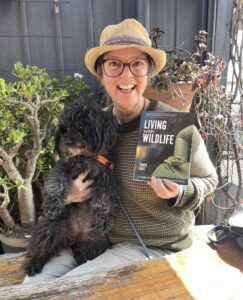
Tanya lives in central Victoria and is passionate about wildlife and nature! She has worked as a Woodland Bird Project Coordinator for Connecting Country and Biodiversity Projects Officer for Macedon Ranges City Council – and at present she is Avian Influenza Response Coordinator at BirdLife Australia.
Tanya loves sharing nature knowledge about how to live more harmoniously with the animals that live where we live – and how our homes and backyards can be safe havens in a time of climate breakdown. Tanya believes there are simple steps we can take that are wildlife friendly and make sure your place is a haven. In her presentations, Tanya loves drawing from ecological science to educate and inspire people to care about wildlife and wildlife habitat.
Tanya will be sharing her passion through an entertaining presentation at the Friends of the Box-Ironbark Forests AGM at 6pm on Monday 8th September at the Castlemaine Senior Citizens Centre, Mechanics Lane, Castlemaine. This will be followed by a light supper and the opportunity to buy Tanya’s book ‘Living with wildlife’, FOBIFs excellent field guides and a raffle ticket for gorgeous lithographs of the anticlinal fold, hakea or banksia by local artist Bev Lewis.
Where: Castlemaine Senior Citizens Centre, Mechanics Lane, Castlemaine.
More information: visit the FOBIF website.
Taking Root and Branching Out
Posted on 24 July, 2025 by Lori
All are invited to this special Landcare Week event, Taking Root and Branching Out hosted by Barkers Creek Landcare and Wildlife Group and Connecting Country at Phee Broadway Theatre on Wednesday 6 August.
Experience an immersive audio documentary by local creative audio producer Kyla Brettle, about the nearly 30-year story of Barkers Creek Wildlife and Landcare Group and the long game to restore health to the natural environments of Central Victoria.
Learn about their new Comprehensive Ecological Repair Plan for the 35 ha bushland reserve in Barkers Creek (Harcourt), and with cutting edge approaches to landscape repair, developed with local ecologist Paul Foreman from Biolinks Alliance.
Be part of a discussion led by Sharon Fraser, with representatives from Barkers Creek Landcare & Wildlife Group, Connecting Country, DJAARA and Biolinks Alliance, exploring strategies for implementing this project and how we can all help to restore health to the natural landscapes of Mt Alexander Shire.
Enjoy a fabulous Landcare ‘morning tea’, or rather, sticky supper.
When: Wednesday 6 August 2025 6:30pm -8:30pm
Where: Phee Broadway Theatre, 212 Barker Street, Castlemaine
Tickets: $15 adult /$10 concession (children under 12 free). Bookings here
This special event is hosted by Barkers Creek Landcare and Wildlife Group and Connecting Country with funding and support from Mount Alexander Shire Council, The Victorian Landcare Program, North Central Catchment Management Authority, Ian and Shirley Norman Foundation, Council, The Little Red Apple, Biolinks Alliance and The Good Opp Shop.
Bird of the Month – Weebill
Posted on 22 July, 2025 by Bonnie Humphreys
Written by Damian Kelly and Jane Rusden
In the local Box-Ironbark forest it’s fairly rare to go for a walk without hearing the Weebill. Although seeing it can be tricky, as typically they are in constant motion as they forage in amongst foliage. A give away is their hover, similar species don’t exhibit this behaviour. The best interactions I’ve had with Weebills, is when I’ve been sitting quietly nature journaling in my sketchbook, and a flock moves through the scrub around me. In these instances they can come very close to you and no binoculars are required to get fantastic views of the tiny but sometimes bold bird.
Measuring from bill tip to tail at 80mm and weighing in at just 6 grams, the Weebill is Australia’s smallest bird, but not by far with the Brown Thornbill just 1 gram heavier on average. As its name implies the bill is also very small and and stumpy which makes it easy to distinguish in the field from other Thornbills that invariably have longer, pointy thorn-like bills. It has been placed in a different genus to the other Thornbills.
A glance at the distribution map for the Weebill shows that it is widespread throughout Australia apart from some inland deserts and tropical rain forest areas. Detailed banding studies have shown the Weebill is a sedentary species with little local movements. Recoveries of banded birds have shown the 99% were recorded less than 10km form original locations. And surprisingly for such a small bird, some recoveries have been of birds over 7 years old.
Food is mostly insects of various kinds, although at times seeds are also taken. Breeding usually occurs August-December, although nesting has been observed at any time of the year when conditions are suitable. Nests are dome-shaped and are built mainly in eucalypt foliage. Clutch size ranges from 2-4 eggs. Both females and males incubate and feed the young.
Calls are quite loud for such a small bird with a whistled song that is quite distinctive and can sound like it’s calling its own name, “Weebill”.
Bird of the Month is a partnership between Connecting Country and BirdLife Castlemaine District. Each month we take a close look at one special local bird species. We are blessed to have the brilliant Jane Rusden and Damian Kelly from BirdLife Castlemaine District writing these! We’re excited to join forces to deliver you a different bird each month, seasonally adjusted, and welcome suggestions from the community.
National Tree Day – POSTPONED TO 24TH AUGUST
Posted on 4 July, 2025 by Lori
Due to inclement weather this event has been postponed for a month to the 24th of August.
National Tree Day was established by Planet Ark in 1996 and is an annual call to action for all Australians to get their hands dirty and give back to the environment.
To celebrate, Connecting Country is partnering with the Friends of Campbells Creek to host a community planting day along the newly completed trail, just upstream from the Princess Street bridge in Campbells Creek.
We will be hoping to plant over 3000 plants which will require many helping hands, big and little! As well as planting, there will be lots of family friendly nature engagement including ‘mini forest’ creations with Wild Families (part of the Victorian National Parks Association) and nature themed craft activities.
FREE BBQ lunch with Rotary to follow.
When: Sunday 27 July 2025 10:00-1:30pm Sunday August 24th 10.00 -1.30pm
Where: Campbells Creek trail, upstream from Princess Street bridge – see map
Please bring: Your own drinking water and your favourite planting tools.
Wear: gardening/leather gloves, hat, and wear sturdy footwear and clothing suitable for the weather. Gumboots might come in handy!
This event offers an opportunity for the Mount Alexander community to come together and take direct on-ground conservation action to restore and enhance our local biodiversity. All welcome!
A bit thank-you to the event sponsors – The Hub Foundation, Community Bank Maldon and District and Mount Alexander Shire Council.
Protecting large, old habitat trees in Metcalfe
Posted on 27 June, 2025 by Bonnie Humphreys
Sarah lives on her family’s farm in Metcalfe. The 30 hectare property has been managed for sheep grazing for many years. While sheep are still agisted within the property, Sarah has her eye on habitat creation and the restoration of indigenous flora across the property – ‘We’ve been adding to the remnant and revegetated areas every year and are already seeing a big increase in birds.’ Saray says.
Sarah’s property has an ephemeral (seasonal) creek line, grassy paddocks, and scattered large old Eucalypt trees, mainly Yellow Box (Eucalyptus melliodora), River Red-gum (Eucalyptus camaldulensis), Long-leaf Box (Eucalyptus goniocalyx) and some Manna Gum (Eucalyptus viminalis). Sarah loves these large old trees ‘These giant old trees are so precious, it’s so good to see them fenced off and protected from hard hooves and nutrient overload, and to see the understory we have planted start to grow up underneath which will soon be full of birds’.
Connecting Country has been very lucky to secure support from the Ian Shirly Norman Foundation in partnership with the Victorian Government NatureFund to run a program over the past 2 years to protect large old Eucalyptus trees within farmland in the Mount Alexander Shire, and to provide succession for the next generation of these to mature. These large old trees are scarce in our landscape, largely due to historic gold-mining, timber harvesting and clearing for agriculture. These trees are so critical for habitat for a range of animal species, particularly threatened species such as the Brush-tailed Phascogale that relies on tree hollows for nesting.
Some key actions within the project included;
- Fencing to exclude stock. Stock increase nutrient loads around trees, as well as introducing weeds and compacting the soil.
- Retaining fallen limbs and leaf litter. These provide homes for insects, foraging resources for small animals and birds, and protection for the soil.
- Planting of understorey species around the trees. This helps provide resources and habitat for animals, who in turn, help manage pests. These plants also provide some direct protection for these large trees.
- Installation of nest boxes. Phascogale nestboxes were installed throughout the property support the threatened species to breed and move through the landscape.
- Providing stock proof guards to protect strategic recruitment of trees within paddocks.
- Controlling pests such as weeds and rabbits

With funding from our project partners, Connecting Country was able to support Sarah to be a step closer to achieving her goals and vision for the property. In June last year she held a planting day. ‘We had around thirty people come and help plant the trees and had a bush dance the evening inviting everyone in Metcalfe. It was so much fun and people are excited to come back next year, see how far the trees have come and plant lots more’.
The plants are off to a great start, especially given the extended dry we have been having and are already popping out of the guards. ‘I can’t think of many better feelings than watching a fairly barren, grazed landscape come back to life, shoot up and begin bursting with biodiversity again’.
Connecting Country is very proud to be able to support properties like Sarah’s and to work with such an enthusiastic and committed community. We acknowledge and are very grateful to the Ian and Shirley Norman Foundation and the Victorian Government (through the Nature Fund) for supporting this valuable work.
My introduction to Galk-galk Dhelkunya (Forest Gardening) – by Chrissi Charles
Posted on 12 June, 2025 by Lori
On a chilly day in May, Connecting Country partnered with Dja Dja Wurrung Aboriginal Clans Corporation (DJAARA) to host a cultural walk through a co-managed site in Leonards Hill. The event provided an opportunity to learn about cultural land management practices, in particular those outlined in DJAARA’s Galk-galk Dhelkunya (Forest Gardening Strategy).
One of the participants on the day, Chrissi Charles, a volunteer with the Friends of Box Ironbark Forests (FOBIF) wrote this beautiful personal account of the day:
My introduction to Galk-galk Dhelkunya (Forest Gardening)
Article by Chrissi Charles, Photos by Bonnie Humphreys
My name is Chrissi, and I am a volunteer with the Friends of Box-Iron Bark Forests. As someone who works as a conservation ecologist, but is new to living on Dja Dja Wurrung Country, I am aware of how little I know and how much I must learn about the cultural and ecological history of this place. On a chilly morning in mid-May, I was lucky enough to nab a spot at a collaborative event hosted by Connecting Country and DJAARA which consisted of talks, conversations and a site tour exploring some of the forest gardening practices outlined in DJAARA’s Galk-galk Dhelkunya Forest Gardening Strategy. The following is a small highlight of what I took away from the amazingly informative morning, plus some extra curricula reading of the strategy. Found here.
 The morning began with a Welcome to Country and smoking ceremony by Dja Dja Wurrung elder Uncle Rick Nelson who emphasised that “everyone is needed to heal country”. As a non-Indigenous person with English, Irish and North American heritage I find it a welcome reminder of the importance of the magnitude of restorative work there is to do, particularly in a landscape that has been so heavily impacted by colonial practices that had little respect for the rich ecology and culture in place.
The morning began with a Welcome to Country and smoking ceremony by Dja Dja Wurrung elder Uncle Rick Nelson who emphasised that “everyone is needed to heal country”. As a non-Indigenous person with English, Irish and North American heritage I find it a welcome reminder of the importance of the magnitude of restorative work there is to do, particularly in a landscape that has been so heavily impacted by colonial practices that had little respect for the rich ecology and culture in place.
After being welcomed onto Djaara country we all funnelled back inside for a presentation by DJAARA employee and Galk-galk Dhelkunya forest gardening project manager Oli Moraes.
The Galk-galk Dhelkunya (translated meaning- to care, to heal, trees and forests) is “Djaara’s contemporary philosophy and practice of managing Djandak’s (Dja Dja Wurrung Country) cultural landscapes” [1]. The strategy is “guided by Dja Dja Wurrung cultural Lore and obligations. Djaara’s connection to Country, cultural rights and obligation have never ceased, nor was sovereignty ever ceded”[2]. The strategy doesn’t shy away from the challenges of incorporating cultural land management practices across a wide variety of tenure types, but it also provides clear guidance and a generous opportunity for non-Djaara land managers to support Djaara priorities.
 Oli’s presentation highlighted the ways in which Dja Dja Wurrung country still bears the scars of relatively recent destructive practices such as gold mining and the intensive forestry that sprung up to bolster the industry.
Oli’s presentation highlighted the ways in which Dja Dja Wurrung country still bears the scars of relatively recent destructive practices such as gold mining and the intensive forestry that sprung up to bolster the industry.
One key historical legacy that Djaara is tackling with the forest gardening practices is the overabundance of galka (trees) across a range of forest types on Djaara country. Too many trees may seem like a strange problem for those not embedded in the world of conservation land management, but an overabundance of trees in some forest types can have negative ecological and cultural consequences. Forests with too many trees (compared to what’s normal for healthy mature forests of that type) can block sunlight from the ground. This can stop smaller plants from growing and reduce the variety of habitats available in the forest. An overabundance of trees also increases the competition for sunlight and nutrients which can cause trees to grow skinnier and straighter than they would if they were in a less competitive environment. While tall straight trees can be useful for timber harvesting (and are natural in some forests), in other forest types, tall skinny straight trees reduce the understory biodiversity and reduce the likelihood that trees will form large limbs which over decades can naturally break off leaving behind tree hollows. Ecologically, large hollow bearing trees are critical habitat for species such as sugar gliders and brush-tailed phascogales who rely on hollows for their homes. On a small scale, a patch of dense trees provides its own unique habitat, however widespread clearing and logging across the region has resulted in many forests with overabundance of dense straight trees and a relative dearth of sparse, large, hollow bearing trees.
Cultural thinning is a culturally responsive method based on the scientific principle of ecological thinning which involves selectively removing some trees to reduce the overall competition for resources and improve the growth rate of the surviving trees. In some forest types, thinning occurs naturally over time; ecological thinning accelerates this process to help create a healthier, more resilient ecosystem that can support a greater diversity of plant and animal life in a shorter time. Like ecological thinning, cultural thinning involves “selectively removing galka in overly dense spaces” for ecological and community benefits. However, cultural thinning has the additional benefit of “reaping cultural outcomes such as increased space for older galka to thrive and utilization of thinned product for tools and artifacts.”[3]
 We were able to view some of the recent outcomes of cultural thinning during the tour which took place in a patch of the Wombat Forest in Leonards Hill, that is co-managed by DJAARA. The patch was a Messmate Stringybark (Eucalyptus obliqua) and Candlebark (Eucalyptus rubida) dominated forest with a scattering of Narrow-leaf and Broad-leaf Peppermints (Eucalyptus radiata and E. dives), Blackwoods (Acacia melanoxylon) and Silver Wattles (Acacia dealbata). The forest had been regularly harvested by Forestry Victoria up until the 1990’s, utilizing a mix of forest harvesting techniques. One third of the site had been clear-felled (all trees removed), with the other two thirds having been selectively logged, with some larger trees left as seed trees. To heal country Djaara have been combining cultural methods with ecological sciences to understand the landscape from multiple perspectives. In studies of the site, the clear-felled area had an average of 2000 tree stems per hectare and in the selectively logged patch there was on average 1000 tree per hectare. A mature patch of this forest type should have around 20 large trees per hectare. If the forest was left to naturally mature (and in the absence of any large-scale fire or other disturbance event) the forest would likely naturally self-thin but this could take hundreds of years.
We were able to view some of the recent outcomes of cultural thinning during the tour which took place in a patch of the Wombat Forest in Leonards Hill, that is co-managed by DJAARA. The patch was a Messmate Stringybark (Eucalyptus obliqua) and Candlebark (Eucalyptus rubida) dominated forest with a scattering of Narrow-leaf and Broad-leaf Peppermints (Eucalyptus radiata and E. dives), Blackwoods (Acacia melanoxylon) and Silver Wattles (Acacia dealbata). The forest had been regularly harvested by Forestry Victoria up until the 1990’s, utilizing a mix of forest harvesting techniques. One third of the site had been clear-felled (all trees removed), with the other two thirds having been selectively logged, with some larger trees left as seed trees. To heal country Djaara have been combining cultural methods with ecological sciences to understand the landscape from multiple perspectives. In studies of the site, the clear-felled area had an average of 2000 tree stems per hectare and in the selectively logged patch there was on average 1000 tree per hectare. A mature patch of this forest type should have around 20 large trees per hectare. If the forest was left to naturally mature (and in the absence of any large-scale fire or other disturbance event) the forest would likely naturally self-thin but this could take hundreds of years.
A key distinction between the ecological practice of thinning and the cultural practice of thinning, is not only the expanded cultural outcomes, but the on-ground approach to thinning. Rather than the scientific outcome of a strict number of stems per hectare, Djaara’s approach to thinning takes a distinct approach, part of which is based on what feels culturally right and what is culturally desired for the landscape.

As we walked around the culturally thinned forest, Oli highlighted that the thinned trees presented as much of a problem as an opportunity and there was no easy fix as to what to do with all the wood. The current approach is a blend of scientific, cultural and trial and error. In some patches trees have been ringbarked to kill the tree but the dead stems are left to naturally fall over; in other patches, trees have been felled, but timber is left on the forest floor; and other patches trees have been cut down and the timber has been removed from the site. Oli highlighted that where timber was removed, it is not Djaara’s intention to make any money out of the harvesting and that the wood was poor quality for use as firewood. However, some pieces of timber are utilised by the on-ground crew for cultural and creative practices. Across the different techniques, Djaara are returning to the site to observe the different ecological responses.
Cultural thinning is only one of the practices that are outlined in Galk-galk Dhelkunya forest gardening, but it was the practice we explored in the most detail during the tour. Other techniques include Djandak Wi (cultural fire practices), revegetation and rehabilitation of Djandak where vegetation has been removed, regenerative practices and partnerships across Djandak and practices to protect gatjin (water) across the landscape[4].
Restoring balance to the landscape both ecologically and culturally is a core element of all the practices in the Galk-galk Dhelkunya forest gardening project. “If you don’t have all the elements of the ecosystem, including Djaara, things are out of balance” shared Oli.
The morning left me feeling lucky to have access to such a generous sharing of knowledge so early into my time living and working on Djaara country and hopeful for future scientific and cultural collaboration.
[1] Page 16 of Galk-galk Dhelkunya Forest Gardening Strategy 2022-2034.
[2] Page 7 of Galk-galk Dhelkunya Forest Gardening Strategy 2022-2034.
[3] Page 31 of Galk-galk Dhelkunya Forest Gardening Strategy 2022-2034.
[4] Pages 31 – 35 of Galk-galk Dhelkunya Forest Gardening Strategy 2022-2034.
The Connecting Country/DJAARA cultural walk was made possible due to to funding from the Ian and Shirley Norman Foundation and the Victorian Government through the Partnership Against Pests Program.
Bird of the Month: Australian Hobby
Posted on 26 May, 2025 by Lori
Article by Damian Kelly with a small addition by Jane Rusden
My research for this article quickly found that the Australian Hobby (Falco longipennis) has been little studied and there are some gaps in its background. This is surprising as it is fairly common in cities and towns including Melbourne, Adelaide and Canberra as well as being found around Castlemaine. Just the other day a Hobby swept across in front of me as I drove down Urquhart Street near the centre of town. They have a preference for using old raven nests when breeding. Once, up near Kerang, I watched an epic battle between a pair of Little Ravens and two Hobbies over the possession of a nest high in an old River Redgum. In this case the hobbies appeared to win the day and at least one raven egg was removed from the nest and smashed on the ground.
Breeding generally occurs in spring and the female lays 2-4 eggs. Both sexes incubate and feed the young. After fledging the family group stays together for up to 12 weeks. Often the parents will do food transfers in flight to improve the abilities of the young.
The Hobby is sometimes confused with the far more charismatic Peregrine Falcon it resembles. It is distinguished from the Peregrine by its smaller size and slighter build with only a partial “helmet” compared to the Peregrine. It also tends to have a brownish breast.
Interestingly, the Latin name ‘longipennis’ comes from the birds long primary wing feathers. Penna singular and pennae plural, is feather in Latin. In ornithological terms, penna refers to a contour feather.
Outside of urban areas the Hobby can be found all over the country from coastal areas to the dry interior and Tasmania. Nesting generally occurs near water. In some areas it is resident but birds often move about with some evidence of north-south and altitudinal movements. Quite an adaptable bird.
They catch birds, bats and insects on the wing often via fast contour hunting hugging the treetops, along creek lines, between buildings or by direct diving from a perch. Diet is primarily birds (70%), with parrots and starlings more common, along with dragonflies. Surprisingly they also are known to take the fast-flying White-throated Needletails. As a crepuscular (at twilight) species it can be observed feeding towards dusk and around dawn, hence the appearance of bats in their diet. It is not unusual to see a Hobby sitting high in a tree watching and waiting for prey.
Bird of the Month is a partnership between Connecting Country and BirdLife Castlemaine District. Each month we take a close look at one special local bird species. We are blessed to have the brilliant Jane Rusden and Damian Kelly from BirdLife Castlemaine District writing these! We’re excited to join forces to deliver you a different bird each month, seasonally adjusted, and welcome suggestions from the community.
Bird of the Month: Brown Thornbill
Posted on 18 March, 2025 by Anna
Brown Thornbill (Acanthiza pusilla)
Welcome to Bird of the Month, a partnership between Connecting Country and BirdLife Castlemaine District. Each month we’re taking a close look at one special local bird species. We are blessed to have the brilliant Jane Rusden and Damian Kelly from BirdLife Castlemaine District writing these! We’re excited to join forces to deliver you a different bird each month, seasonally adjusted, and welcome suggestions from the community.
The Brown Thornbill is one of the typical “little brown birds” that are always moving fast in foliage and thus hard to identify. It is the only Thornbill species found locally with a red eye, which is a helpful distinguishing feature to look out for, though tough to see in certain light conditions.
The Brown Thornbill can be found in a wide variety of habitats along the east coast of Australia from northern Queensland around to South Australia as well as Tasmania. This adaptable species occurs in a range of habitats with a dense shrub layer, including wet and dry eucalypt forests, as well as heathlands and rainforests. Brown Thornbills have been recorded as high as 1200m in Victoria down to coastal areas. They can also be found in suburban gardens – in fact as I type this I am watching one have a good splash in a water bowl near my window.
A predominantly insectivorous species, it gleans most of its food from foliage and tree trunks as well as foraging on the ground. Occasionally it has been observed eating seeds, fruit and nuts when available.
Long term banding studies have shown that adults are predominantly sedentary although some movements occur from high zones to lower areas in winter. Young birds, however, do disperse to new areas when full fledged. Unlike some Australian species, Brown Thornbills do not have helpers at the nest and broods are raised by the pair. Nesting can occur from June to January, depending on the season and nests are built quite low down in dense shrubbery or even in grass tussocks. Nests are rounded, oval and domed with an entrance near the top. Materials include grasses, lichen, moss, and wool if available, bound together with spider web. Males and females appear very similar and juveniles are equally hard to separate from their parents once fully fledged.

The red eye of the Brown Thornbill is more difficult to see in these conditions. Photo by Damian Kelly.


